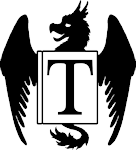Drawing from Your Imagination
Ron Tiner
David & Charles
Nonfiction, Art
***+
Description
Robin Hood and his band of thieves, the streets of Victorian London, a mystical soothsayer, a distant planetscape... working artists often have to depict people and places that no longer exist - or never existed outside of the human imagination. Their images must set a mood and tell a story, in addition to matching a specific description. Successful illustrator Ron Tiner discusses how to develop the important artistic skill of imaginative drawing, creating an extensive mental catalog of images and ideas for use in professional and personal artwork, with numerous examples from his own sketchbooks and portfolio.
Review
This isn't so much a how-to-draw book as it is a guidebook for aspiring professional artists and illustrators. You won't find the usual breakdowns of anatomy, shading, perspective, or other basic topics here. Instead, Tiner discusses methods for honing the artistic eye and mind, based largely on life drawing and observation, balanced with playful forays into imagination. It reads more like a lecture series than an art instruction book, discussing several topics while suggesting self-study options. A fair chunk of it reads like a rehash of information Tiner delivered in his other book, Figure Drawing Without a Model, only here it seems less succinct for some reason. More useful are the sections where Tiner breaks down actual projects, paid and personal, showing the process of development. Sometimes Tiner seems to be rushing his explanations, relying too heavily on the idea that his readers have received (or are receiving) instruction elsewhere. The points of his included sketches, consequently, aren't always as clear as I think he believed. Still, there's plenty of worthwhile information here. While not a standalone book by any means, this should be useful for any artist who wants to grow beyond the fundamentals.
